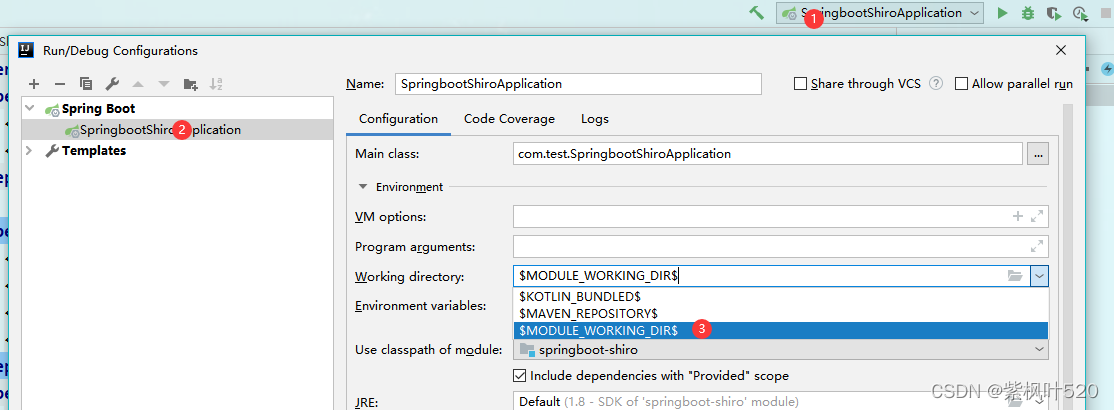在B站上看了shiro的教学视频,觉得讲的挺不错的,根据自己的理解,记录一下学习笔记
应用场景是springboot的单体应用
一、整合思路
直接从教学视频中,截取的图片:
主要就是在之前认证的基础上,在中间加入了shiro框架,加上shiro过滤器
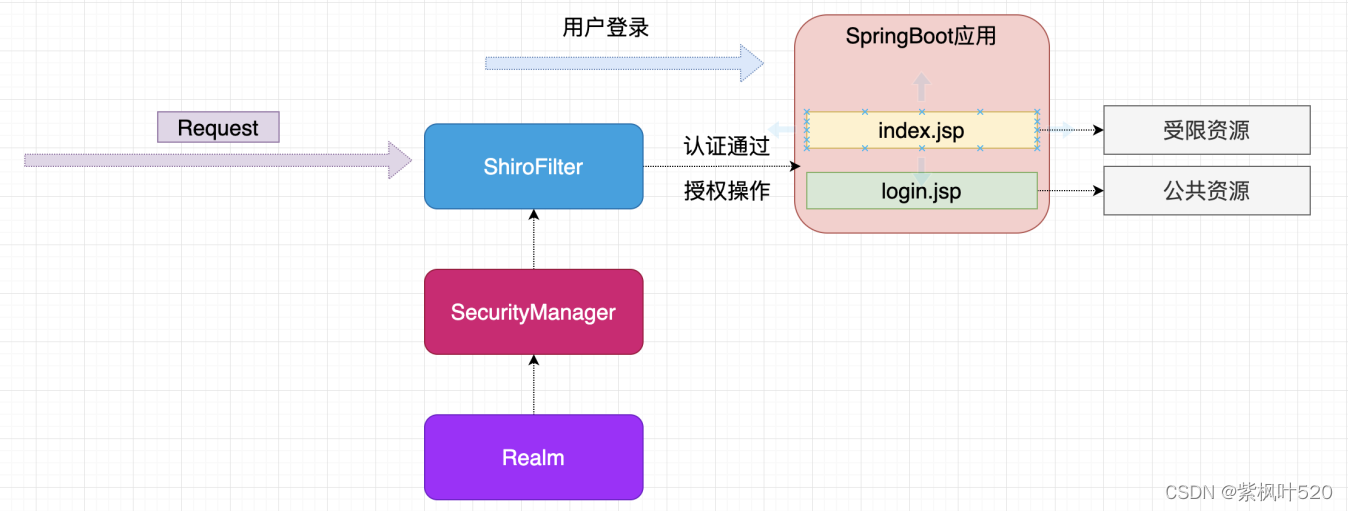
二、搭建简单的web应用
1、创建应用
创建一个简单的springboot项目,勾选lombok、热部署、和spring web等必要的组件
在main目录下添加webapp目录,并新建jsp文件
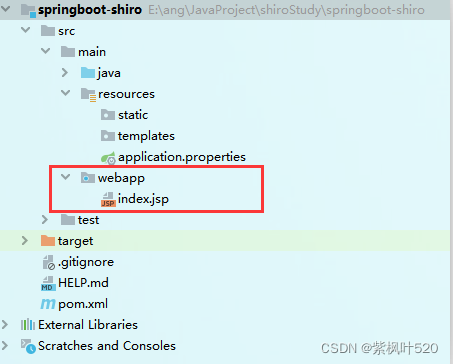
2、添加jsp依赖
<!--引入JSP解析依赖-->
<dependency>
<groupId>org.apache.tomcat.embed</groupId>
<artifactId>tomcat-embed-jasper</artifactId>
</dependency>3、配置properties
server.port=8888
server.servlet.context-path=/4、访问页面
启动项目,访问http://localhost:8888/index.jsp
5、如果访问jsp页面报错,进行如下配置
修改一些idea的配置,选择带有module的即可,重启再去访问
三、整合shiro
1、添加整合依赖
<!--整合包-->
<dependency>
<groupId>org.apache.shiro</groupId>
<artifactId>shiro-spring-boot-starter</artifactId>
<version>1.4.0</version>
</dependency>2、先创建一个自定义的Realm
里面实现的方法,暂时都返回为null,表示认证是授权失败
public class MyRealm extends AuthorizingRealm {
@Override
protected AuthorizationInfo doGetAuthorizationInfo(PrincipalCollection principalCollection) {
return null;
}
@Override
protected AuthenticationInfo doGetAuthenticationInfo(AuthenticationToken authenticationToken) throws AuthenticationException {
return null;
}
}3、创建shiro的过滤器,用来拦截请求
先拦截一个index.jsp页面资源,用来测试整合是否成功
@Configuration
public class ShiroConfig {
//创建过滤器,拦截所有请求
@Bean
public ShiroFilterFactoryBean getShiroFilterFactoryBean(DefaultWebSecurityManager defaultWebSecurityManager){
ShiroFilterFactoryBean shiroFilterFactoryBean = new ShiroFilterFactoryBean();
shiroFilterFactoryBean.setSecurityManager(defaultWebSecurityManager);
//设置角色和资源等权限
Map map = new HashMap<>();
map.put("/index.jsp","authc");
shiroFilterFactoryBean.setLoginUrl("login.jsp");//默认就是login.jsp
shiroFilterFactoryBean.setFilterChainDefinitionMap(map);
return shiroFilterFactoryBean;
}
//创建安全管理器
@Bean
public DefaultWebSecurityManager getSecurityManager(Realm myRealm){
//要用Web
DefaultWebSecurityManager securityManager = new DefaultWebSecurityManager();
securityManager.setRealm(myRealm);
return securityManager;
}
//创建自定义的Realm
@Bean("myRealm")
public Realm getRealm(){
return new MyRealm();
}
}4、创建login页面
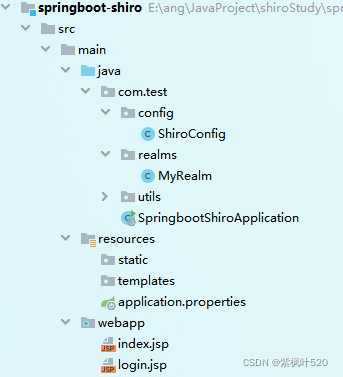
5、测试
访问http://localhost:8888/index.jsp,会重定向到login页面
因为在realm中,授权的时候,返回的是null,没有完成认证
四、整合mybatis-plus
1、整合步骤
参考:https://blog.csdn.net/zifengye520/article/details/121989659
2、创建测试的数据库表
sql如下:
SET NAMES utf8mb4;
SET FOREIGN_KEY_CHECKS = 0;
-- ----------------------------
-- Table structure for perms
-- ----------------------------
DROP TABLE IF EXISTS `perms`;
CREATE TABLE `perms` (
`id` varchar(64) CHARACTER SET utf8 COLLATE utf8_general_ci NOT NULL,
`name` varchar(255) CHARACTER SET utf8 COLLATE utf8_general_ci DEFAULT NULL,
`url` varchar(255) CHARACTER SET utf8 COLLATE utf8_general_ci DEFAULT NULL,
PRIMARY KEY (`id`) USING BTREE
) ENGINE = InnoDB CHARACTER SET = utf8 COLLATE = utf8_general_ci ROW_FORMAT = Dynamic;
-- ----------------------------
-- Table structure for role
-- ----------------------------
DROP TABLE IF EXISTS `role`;
CREATE TABLE `role` (
`id` varchar(64) CHARACTER SET utf8 COLLATE utf8_general_ci NOT NULL,
`rolename` varchar(255) CHARACTER SET utf8 COLLATE utf8_general_ci DEFAULT NULL,
PRIMARY KEY (`id`) USING BTREE
) ENGINE = InnoDB CHARACTER SET = utf8 COLLATE = utf8_general_ci ROW_FORMAT = Dynamic;
-- ----------------------------
-- Table structure for role_perm
-- ----------------------------
DROP TABLE IF EXISTS `role_perm`;
CREATE TABLE `role_perm` (
`id` varchar(64) CHARACTER SET utf8 COLLATE utf8_general_ci NOT NULL,
`roleid` varchar(64) CHARACTER SET utf8 COLLATE utf8_general_ci DEFAULT NULL,
`permid` varchar(64) CHARACTER SET utf8 COLLATE utf8_general_ci DEFAULT NULL,
PRIMARY KEY (`id`) USING BTREE
) ENGINE = InnoDB CHARACTER SET = utf8 COLLATE = utf8_general_ci ROW_FORMAT = Dynamic;
-- ----------------------------
-- Table structure for user
-- ----------------------------
DROP TABLE IF EXISTS `user`;
CREATE TABLE `user` (
`id` varchar(64) CHARACTER SET utf8 COLLATE utf8_general_ci NOT NULL,
`username` varchar(255) CHARACTER SET utf8 COLLATE utf8_general_ci DEFAULT NULL,
`password` varchar(255) CHARACTER SET utf8 COLLATE utf8_general_ci DEFAULT NULL,
`salt` varchar(255) CHARACTER SET utf8 COLLATE utf8_general_ci DEFAULT NULL,
PRIMARY KEY (`id`) USING BTREE
) ENGINE = InnoDB CHARACTER SET = utf8 COLLATE = utf8_general_ci ROW_FORMAT = Dynamic;
-- ----------------------------
-- Table structure for user_role
-- ----------------------------
DROP TABLE IF EXISTS `user_role`;
CREATE TABLE `user_role` (
`id` varchar(64) CHARACTER SET utf8 COLLATE utf8_general_ci NOT NULL,
`userid` varchar(64) CHARACTER SET utf8 COLLATE utf8_general_ci DEFAULT NULL,
`roleid` varchar(64) CHARACTER SET utf8 COLLATE utf8_general_ci DEFAULT NULL,
PRIMARY KEY (`id`) USING BTREE
) ENGINE = InnoDB CHARACTER SET = utf8 COLLATE = utf8_general_ci ROW_FORMAT = Dynamic;
SET FOREIGN_KEY_CHECKS = 1;3、整合之后的项目结构
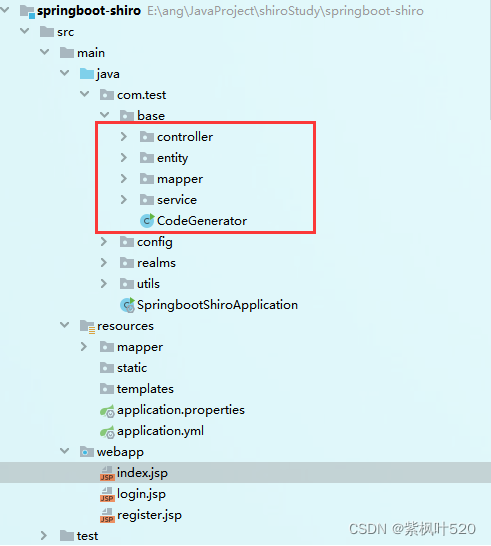
五、实现注册功能
1、创建注册页面:register.jsp
<%@ page contentType="text/html;charset=UTF-8" language="java" %>
<html>
<head>
<title>register</title>
</head>
<body>
<form method="post" action="${pageContext.request.contextPath}/user/register">
用户名:<input name="username" value="" type="text" /><br/>
密码:<input name="password" value="" type="password" /><br/>
<input name="" type="submit" value="注册" />
</form>
</body>
</html>2、配置视图
spring.mvc.view.prefix=/
spring.mvc.view.suffix=.jsp3、创建获取随机盐的工具类
public class SaltUtil {
private static final String str = "ABCDEFGHIJKLMNOPQRSTUVWXYZ0123456789";
public static String getRandomSalt(int num){
StringBuffer salt = new StringBuffer();
IntStream.range(0,num).forEach(i->{
Random random = new Random();
//获取随机下标
int index = random.nextInt(str.length()+1);
//获取字符
char result = str.charAt(index);
salt.append(result);
});
return salt.toString();
}
}4、UserController添加注册方法
@PostMapping("/register")
public String register(User user){
if(StringUtils.isNullOrEmpty(user.getUsername()) || StringUtils.isNullOrEmpty(user.getPassword())){
return "register";
// return "redirect:/register.jsp";//跳转页面,注意路径,用绝对路径,否则会加上class的前缀
// return "redirect:toRegister";//跳转接口
}
String salt = SaltUtil.getRandomSalt(5);
String password = user.getPassword();
String newPassword = new Md5Hash(password,salt,1024).toHex();
user.setPassword(newPassword);
user.setSalt(salt);
userService.save(user);
return "login";
}5、测试
访问页面:http://localhost:8888/user/register.jsp
输入:zhangsan | 1234,并点击按钮
查看数据库,发现注册成功

六、登录认证和退出
一、登录认证
1、修改Realm
首先要修改ShiroConfig中的Realm,因为要登录要用到盐值加密,所以需要修改Realm中的凭证匹配器
//创建自定义的Realm
@Bean("myRealm")
public Realm getRealm(){
MyRealm myRealm = new MyRealm();
//设置hashed凭证匹配器
HashedCredentialsMatcher credentialsMatcher = new HashedCredentialsMatcher();
credentialsMatcher.setHashAlgorithmName("md5");//加密方式md5
credentialsMatcher.setHashIterations(1024);//散列次数,1024
myRealm.setCredentialsMatcher(credentialsMatcher);
return myRealm;
}2、创建登录方法
可以直接使用SecurityUtils来获取主体
在ShiroConfig中配置了DefaultWebSecurityManager,会自动注入到SecurityUtils中
@Controller
public class LoginController {
@RequestMapping("/login")
public String login(User user){
UsernamePasswordToken token = new UsernamePasswordToken(user.getUsername(),user.getPassword());
Subject subject = SecurityUtils.getSubject();
try{
subject.login(token);
}catch (UnknownAccountException e){
//账号不存在
System.out.println("账号不存在");
return "register";
}catch (IncorrectCredentialsException e){
//密码不正确
System.out.println("密码不正确");
return "login";
}
return "index";
}
}3、编辑login页面
<%@ page contentType="text/html;charset=UTF-8" language="java" %>
<html>
<head>
<title>Login</title>
</head>
<body>
<form method="post" action="${pageContext.request.contextPath}/login">
用户名:<input name="username" value="" type="text" /><br/>
密码:<input name="password" value="" type="password" /><br/>
<input name="" type="submit" value="登录" />
</form>
</body>
</html>4、添加工具类,ApplicationContextUtil
添加一个工具类ApplicationContextUtil,用来获取spring容器中的bean,后面的realm中会用到
@Component
public class ApplicationContextUtil implements ApplicationContextAware {
private static ApplicationContext context;
@Override
public void setApplicationContext(ApplicationContext applicationContext) throws BeansException {
this.context = applicationContext;
}
//获取上下文路径
public static ApplicationContext getContext(){
return context;
}
//获取bean
public static Object getBean(String beanName){
return context.getBean(beanName);
}
}5、修改Realm
修改自定义的Realm,从数据源获取用户信息,修改doGetAuthenticationInfo方法
@Override
protected AuthenticationInfo doGetAuthenticationInfo(AuthenticationToken authenticationToken) throws AuthenticationException {
String principal = (String) authenticationToken.getPrincipal();
if(!StringUtils.isNullOrEmpty(principal)){
UserService userServiceImpl = (UserService) ApplicationContextUtil.getBean("userServiceImpl");
QueryWrapper wrapper = new QueryWrapper();
wrapper.eq("username",principal);
User user = userServiceImpl.getOne(wrapper);
if(user!=null){
SimpleAuthenticationInfo info = new SimpleAuthenticationInfo(user.getUsername(),user.getPassword(),ByteSource.Util.bytes(user.getSalt()),this.getName());
return info;
}
}
return null;
}6、测试
1)使用test登录,跳转到register页面,后台打印:账号不存在
2)使用zhangsan登录,随便输入密码,跳转到login页面,后台打印:密码不正确
3)使用zhangsan | 1234登录,进入到index页面
二、退出
1、编辑index页面,添加退出连接
<a href="${pageContext.request.contextPath}/logout">退出登录</a>2、添加退出方法
@RequestMapping("/logout")
public String logout(){
Subject subject = SecurityUtils.getSubject();
subject.logout();
return "login";
}3、测试
使用zhangsan | 1234登录,进入index页面
点击退出按钮,会进入login页面,测试在URL地址栏输入index.jsp,会发现自动跳转到login页面,因为已经退出成功
七、权限认证
1、数据库
插入测试数据,sql:
-- ----------------------------
-- Records of perms
-- ----------------------------
INSERT INTO `perms` VALUES ('1', 'admin:*:*', NULL);
INSERT INTO `perms` VALUES ('2', 'user:*:*', NULL);
INSERT INTO `perms` VALUES ('3', 'user:find:*', NULL);
INSERT INTO `perms` VALUES ('4', 'product:*:*', NULL);
-- ----------------------------
-- Records of role
-- ----------------------------
INSERT INTO `role` VALUES ('1', 'admin');
INSERT INTO `role` VALUES ('2', 'user');
INSERT INTO `role` VALUES ('3', 'product');
-- ----------------------------
-- Records of role_perm
-- ----------------------------
INSERT INTO `role_perm` VALUES ('1', '1', '1');
INSERT INTO `role_perm` VALUES ('2', '1', '3');
INSERT INTO `role_perm` VALUES ('3', '2', '2');
INSERT INTO `role_perm` VALUES ('4', '3', '3');
-- ----------------------------
-- Records of user
-- ----------------------------
INSERT INTO `user` VALUES ('1', 'admin', '7508cf15e102d437b3d2fd9238d4505e', 'PDTOK');
INSERT INTO `user` VALUES ('2', 'user', '3611dbe2193e0ffd93c2befabfc1d3f9', 'BAMAM');
INSERT INTO `user` VALUES ('3', 'guest', '9697df20425e3d5ac9d0f923f3dcb7f0', 'P6AP8');
-- ----------------------------
-- Records of user_role
-- ----------------------------
INSERT INTO `user_role` VALUES ('1', '1', '1');
INSERT INTO `user_role` VALUES ('2', '2', '2');
INSERT INTO `user_role` VALUES ('3', '3', '3');2、index页面添加shiro标签
注意:shiro标签的引入
<%@ page contentType="text/html;charset=UTF-8" language="java" %>
<%@ taglib prefix="shiro" uri="http://shiro.apache.org/tags" %>
<html>
<head>
<title>index</title>
</head>
<body>
<a href="${pageContext.request.contextPath}/logout">退出登录</a>
<h5>所有角色都能看</h5>
<shiro:hasRole name="admin">
<h5>admin角色才能看</h5>
</shiro:hasRole>
<shiro:hasRole name="user">
<h5>user角色才能看</h5>
</shiro:hasRole>
<shiro:hasAnyRoles name="admin,user">
<h5>admin或者user角色才能看</h5>
</shiro:hasAnyRoles>
<shiro:hasPermission name="user:*:*">
<h5>user:*:*资源才能看</h5>
</shiro:hasPermission>
<shiro:hasPermission name="user:find:*">
<h5>user:find:*资源才能看</h5>
</shiro:hasPermission>
<shiro:hasPermission name="admin:*:*">
<h5>admin:*:*资源才能看</h5>
</shiro:hasPermission>
<shiro:hasPermission name="admin:*:*">
<h5>product:*:*资源才能看</h5>
</shiro:hasPermission>
</body>
</html>3、修改role和user对象,添加关联的集合属性
User:
@Data
@NoArgsConstructor
@AllArgsConstructor
public class User extends Model<User> {
private static final long serialVersionUID = 1L;
private String id;
private String username;
private String password;
private String salt;
@TableField(exist = false)
private List<Role> roleList;
}Role:
@Data
public class Role extends Model<Role> {
private static final long serialVersionUID = 1L;
@TableId(value = "id", type = IdType.AUTO)
private String id;
private String rolename;
@TableField(exist = false)
private List<Perms> permsList;
}4、添加查询接口
添加2个查询接口和sql:根据名称查询用户,根据角色查询权限
查询sql:
<!-- 通用查询映射结果 -->
<resultMap id="BaseResultMap" type="com.test.base.entity.User">
<id column="userId" property="id" />
<result column="username" property="username" />
<result column="password" property="password" />
<result column="salt" property="salt" />
<collection property="roleList" ofType="com.test.base.entity.Role">
<id column="roleId" property="id" />
<result column="rolename" property="rolename" />
</collection>
</resultMap>
<select id="getUserList" resultMap="BaseResultMap">
SELECT
u.id as userId,u.username,r.id as roleId,r.rolename
FROM
USER u
LEFT JOIN user_role ur ON u.id = ur.userid
LEFT JOIN role r ON r.id = ur.roleid
WHERE u.username = #{username}
</select>
<select id="getPermByRole" resultType="com.test.base.entity.Perms">
SELECT
p.id,p.name,p.url
FROM
role r
LEFT JOIN role_perm rp ON r.id=rp.roleid
LEFT JOIN perms p ON rp.permid=p.id
WHERE r.id=#{roleId}
</select>mapper接口:
public interface UserMapper extends BaseMapper<User> {
List<User> getUserList(String username);
List<Perms> getPermByRole(String roleId);
}service层省略
5、修改自定义Realm中的授权方法
@Override
protected AuthorizationInfo doGetAuthorizationInfo(PrincipalCollection principalCollection) {
String primaryPrincipal = (String) principalCollection.getPrimaryPrincipal();
UserService userServiceImpl = (UserService) ApplicationContextUtil.getBean("userServiceImpl");
//获取用户
List<User> userList = userServiceImpl.getUserList(primaryPrincipal);
if(userList==null || userList.size()==0){
return null;
}
SimpleAuthorizationInfo simpleAuthorizationInfo = new SimpleAuthorizationInfo();
User user = userList.get(0);
//遍历用户角色
user.getRoleList().forEach(role -> {
//获取角色对应的资源权限
List<Perms> permsList = userServiceImpl.getPermByRole(role.getId());
permsList.forEach(perms -> {
//添加资源权限
simpleAuthorizationInfo.addStringPermission(perms.getName());
});
//添加角色权限
simpleAuthorizationInfo.addRole(role.getRolename());
});
return simpleAuthorizationInfo;
}6、登录不同账号,进行验证
-----------------------------------------
user登录:角色:user,资源:user:*:*(包含user:find:*)

-----------------------------------------
guest登录:没有角色和资源

-----------------------------------------
admin登录:角色:admin,资源:admin:*:*、user:find:*

八、缓存的基本使用
前提:
在index页面,每次刷新页面,因为shiro标签,每次都会进行权限认证操作,调用doGetAuthorizationInfo方法会去数据库查询数据
加入页面有N个shiro标签,就会去调用doGetAuthorizationInfo方法N次
加入缓存之后的对比:
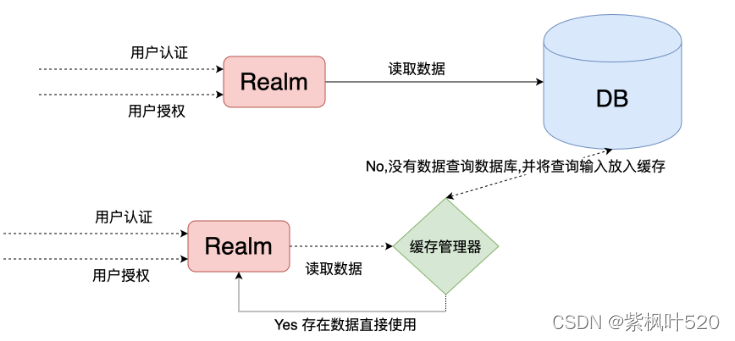
一、缓存管理器介绍
1、可以在Realm中定义缓存管理器(见1)
2、可以在SecurityManager中定义缓存管理器(见2)
3、一般在Realm中设置,因为在manager中设置,最终还是给realm使用(见3)
1、查看自定义realm的类图,或者通过点击extends,可以看到MyRealm继承了CachingRealm
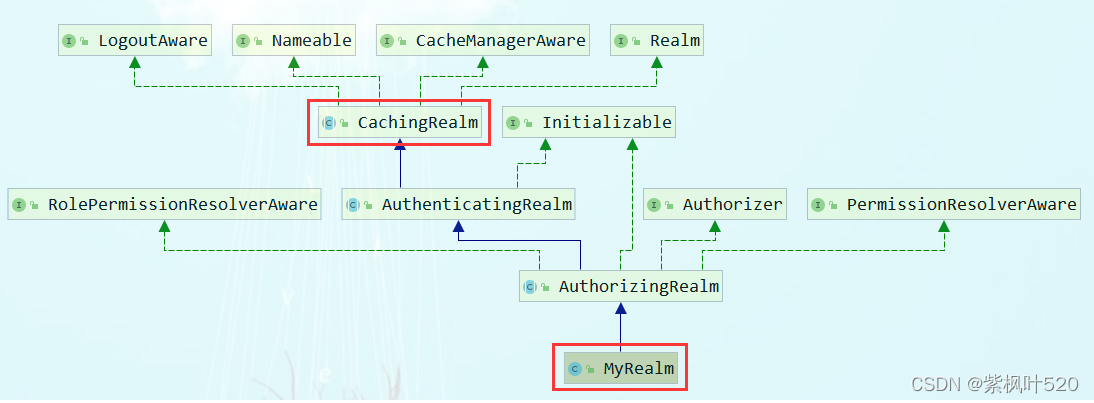
查看CachingRealm的源码,可以看到CacheManager的变量和开关
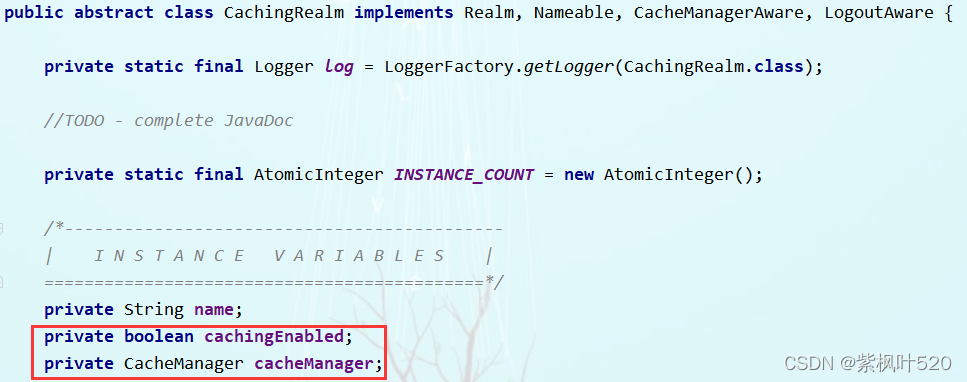
2、使用的安全管理器DefaultWebSecurityManager,查看其类关系图
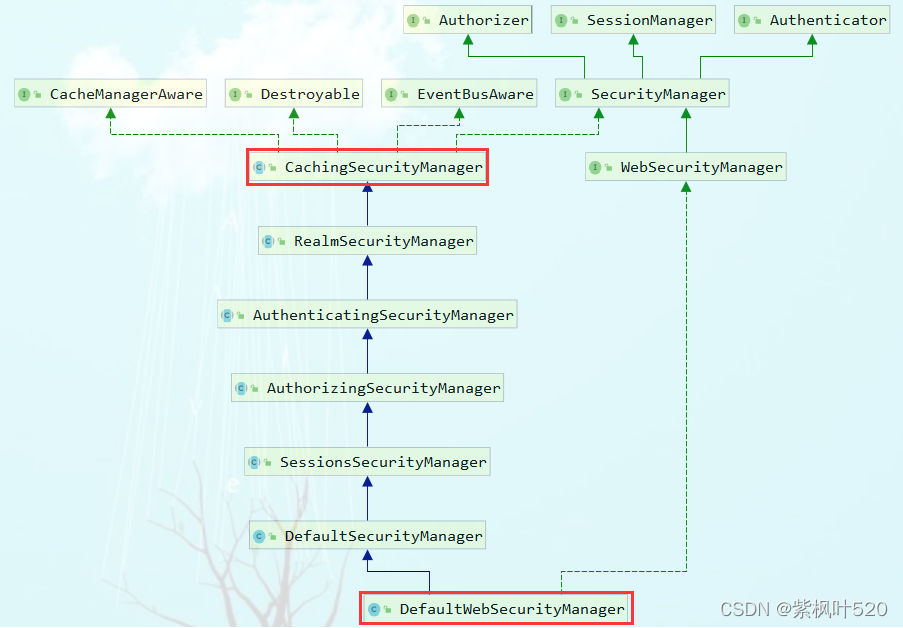
查看CachingSecurityManager源码:

3、看一下org.apache.shiro.mgt.RealmSecurityManage的源码实现:
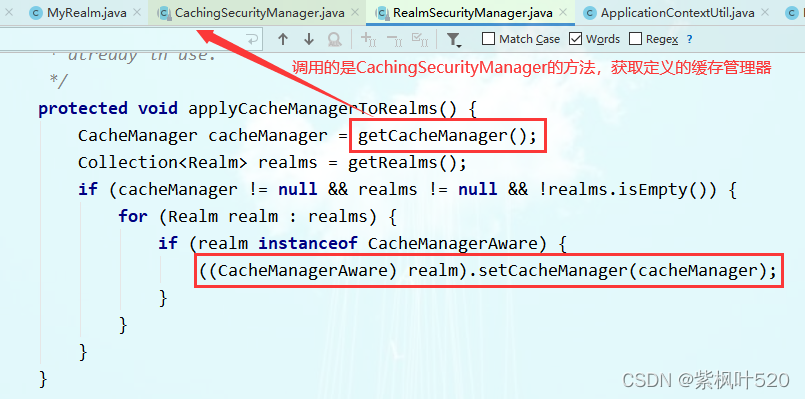
二、添加缓存管理器
1、添加依赖
<!--引入shiro和ehcache-->
<dependency>
<groupId>org.apache.shiro</groupId>
<artifactId>shiro-ehcache</artifactId>
<version>1.5.3</version>
</dependency>2、修改ShiroConfig
在shiro配置类中,定义Realm的时候,给自定义的Realm设置缓存管理器
@Bean("myRealm")
public Realm getRealm(){
MyRealm myRealm = new MyRealm();
//设置hashed凭证匹配器
HashedCredentialsMatcher credentialsMatcher = new HashedCredentialsMatcher();
credentialsMatcher.setHashAlgorithmName("md5");//加密方式md5
credentialsMatcher.setHashIterations(1024);//散列次数,1024
myRealm.setCredentialsMatcher(credentialsMatcher);
//开启缓存,设置缓存管理器
myRealm.setCachingEnabled(true);
myRealm.setAuthenticationCachingEnabled(true);
myRealm.setAuthorizationCachingEnabled(true);
myRealm.setCacheManager(new EhCacheManager());
return myRealm;
}3、测试
此时登录login,访问index,第一次会访问数据库,再次刷新页面的时候,不会再去访问数据库,也不会进去doGetAuthorizationInfo方法
九、使用redis缓存
1、添加依赖
<!--redis整合springboot-->
<dependency>
<groupId>org.springframework.boot</groupId>
<artifactId>spring-boot-starter-data-redis</artifactId>
</dependency>2、配置文件
#redis
spring.redis.port=6379
spring.redis.host=localhost
spring.redis.database=03、自定义缓存管理器,实现CacheManager
public class RedisCacheManager implements CacheManager {
@Override
public <K, V> Cache<K, V> getCache(String s) throws CacheException {
//返回自定义的缓存实现
return new RedisCache<K,V>(s);
}
}4、自定义缓存实现类,实现Cache<K,V>
public class RedisCache<K,V> implements Cache<K,V> {
private String name ;
public RedisCache(){
}
public RedisCache(String name){
System.out.println("name="+name);
this.name = name;
}
private RedisTemplate getRedisTemplate(){
RedisTemplate redisTemplate = (RedisTemplate) ApplicationContextUtil.getBean("redisTemplate");
redisTemplate.setKeySerializer(new StringRedisSerializer());
redisTemplate.setHashKeySerializer(new StringRedisSerializer());
return redisTemplate;
}
@Override
public V get(K k) throws CacheException {
System.out.println("------------------get from "+k.toString());
return (V) getRedisTemplate().opsForHash().get(name,k.toString());
}
@Override
public V put(K k, V v) throws CacheException {
System.out.println("------------------put "+ v +" with "+k.toString());
getRedisTemplate().opsForHash().put(name,k.toString(),v);
return null;
}
@Override
public V remove(K k) throws CacheException {
System.out.println("------------------delete "+k.toString());
getRedisTemplate().opsForHash().delete(name,k.toString());
return null;
}
@Override
public void clear() throws CacheException {
System.out.println("------------------clear");
getRedisTemplate().opsForHash().delete(name);
}
@Override
public int size() {
return 0;
}
@Override
public Set<K> keys() {
return getRedisTemplate().opsForHash().keys(this.name);
}
@Override
public Collection<V> values() {
return getRedisTemplate().opsForHash().values(this.name);
}
}5、修改ShiroConfig
在配置类中修改realm的缓存管理器
@Bean("myRealm")
public Realm getRealm(){
MyRealm myRealm = new MyRealm();
//设置hashed凭证匹配器
HashedCredentialsMatcher credentialsMatcher = new HashedCredentialsMatcher();
credentialsMatcher.setHashAlgorithmName("md5");//加密方式md5
credentialsMatcher.setHashIterations(1024);//散列次数,1024
myRealm.setCredentialsMatcher(credentialsMatcher);
//开启缓存,设置缓存管理器
myRealm.setCachingEnabled(true);
myRealm.setAuthenticationCachingEnabled(true);
myRealm.setAuthorizationCachingEnabled(true);
// myRealm.setCacheManager(new EhCacheManager());
myRealm.setCacheManager(new RedisCacheManager());
return myRealm;
}6、但是此时去login页面登录会报错
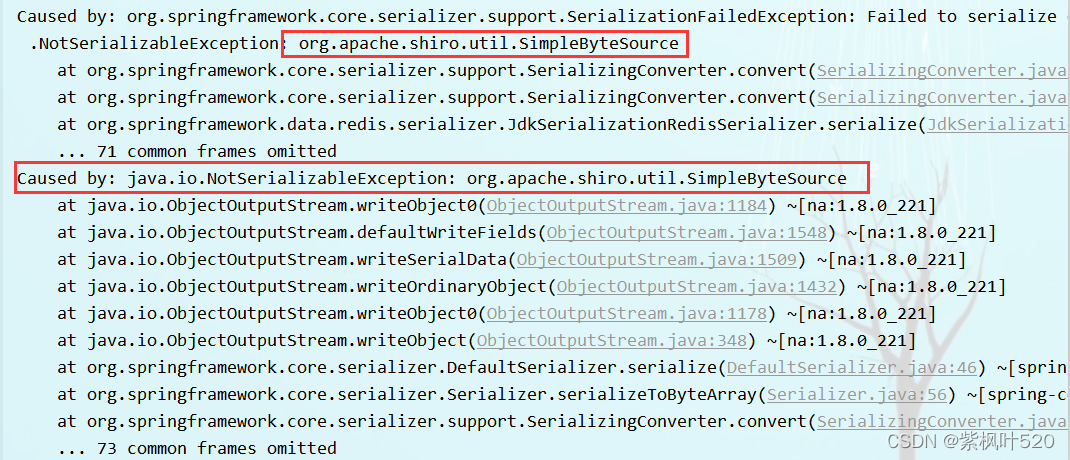
出错原因:由于shiro中提供的simpleByteSource实现,没有实现序列化,所以在认证时出现错误信息
解决方法:自定义salt实现,实现序列化接口
7、自定义salt的实现
有2种方式:
1)实现ByteSource接口和Serializable接口,要实现ByteSource的所有方法,比较麻烦,如下:
public class CustomSimpleByteSource implements ByteSource, Serializable {
private static final long serialVersionUID = 1L;
private byte[] bytes;
private String cachedHex;
private String cachedBase64;
public CustomSimpleByteSource(){
}
public CustomSimpleByteSource(byte[] bytes) {
this.bytes = bytes;
}
public CustomSimpleByteSource(char[] chars) {
this.bytes = CodecSupport.toBytes(chars);
}
public CustomSimpleByteSource(String string) {
this.bytes = CodecSupport.toBytes(string);
}
public CustomSimpleByteSource(ByteSource source) {
this.bytes = source.getBytes();
}
public CustomSimpleByteSource(File file) {
this.bytes = (new com.test.redis.CustomSimpleByteSource.BytesHelper()).getBytes(file);
}
public CustomSimpleByteSource(InputStream stream) {
this.bytes = (new com.test.redis.CustomSimpleByteSource.BytesHelper()).getBytes(stream);
}
public static boolean isCompatible(Object o) {
return o instanceof byte[] || o instanceof char[] || o instanceof String || o instanceof ByteSource || o instanceof File || o instanceof InputStream;
}
public byte[] getBytes() {
return this.bytes;
}
public boolean isEmpty() {
return this.bytes == null || this.bytes.length == 0;
}
public String toHex() {
if (this.cachedHex == null) {
this.cachedHex = Hex.encodeToString(this.getBytes());
}
return this.cachedHex;
}
public String toBase64() {
if (this.cachedBase64 == null) {
this.cachedBase64 = Base64.encodeToString(this.getBytes());
}
return this.cachedBase64;
}
public String toString() {
return this.toBase64();
}
public int hashCode() {
return this.bytes != null && this.bytes.length != 0 ? Arrays.hashCode(this.bytes) : 0;
}
public boolean equals(Object o) {
if (o == this) {
return true;
} else if (o instanceof ByteSource) {
ByteSource bs = (ByteSource)o;
return Arrays.equals(this.getBytes(), bs.getBytes());
} else {
return false;
}
}
private static final class BytesHelper extends CodecSupport {
private BytesHelper() {
}
public byte[] getBytes(File file) {
return this.toBytes(file);
}
public byte[] getBytes(InputStream stream) {
return this.toBytes(stream);
}
}
}2)自定义一个类,继承SimpleByteSource 和 实现Serializable接口
public class MyByteSource extends SimpleByteSource implements Serializable {
private static final long serialVersionUID = 1L;
public MyByteSource(String string) {
super(string);
}
}8、修改认证的实现方法
在自定义Realm中,修改认证的实现方法
@Override
protected AuthenticationInfo doGetAuthenticationInfo(AuthenticationToken authenticationToken) throws AuthenticationException {
System.out.println("--------------------开始认证--------------------");
String principal = (String) authenticationToken.getPrincipal();
if(!StringUtils.isNullOrEmpty(principal)){
UserService userServiceImpl = (UserService) ApplicationContextUtil.getBean("userServiceImpl");
QueryWrapper wrapper = new QueryWrapper();
wrapper.eq("username",principal);
//查询用户
User user = userServiceImpl.getOne(wrapper);
//如果存在,返回
if(user!=null){
// SimpleAuthenticationInfo info = new SimpleAuthenticationInfo(user.getUsername(),user.getPassword(),
// ByteSource.Util.bytes(user.getSalt()),this.getName());
// SimpleAuthenticationInfo info = new SimpleAuthenticationInfo(user.getUsername(),user.getPassword(),
// new CustomSimpleByteSource(user.getSalt()),this.getName());
SimpleAuthenticationInfo info = new SimpleAuthenticationInfo(user.getUsername(),user.getPassword(),
new MyByteSource(user.getSalt()),this.getName());
return info;
}
}
return null;
}此时,再去登录,可以正常登录,也可以正常保存redis缓存
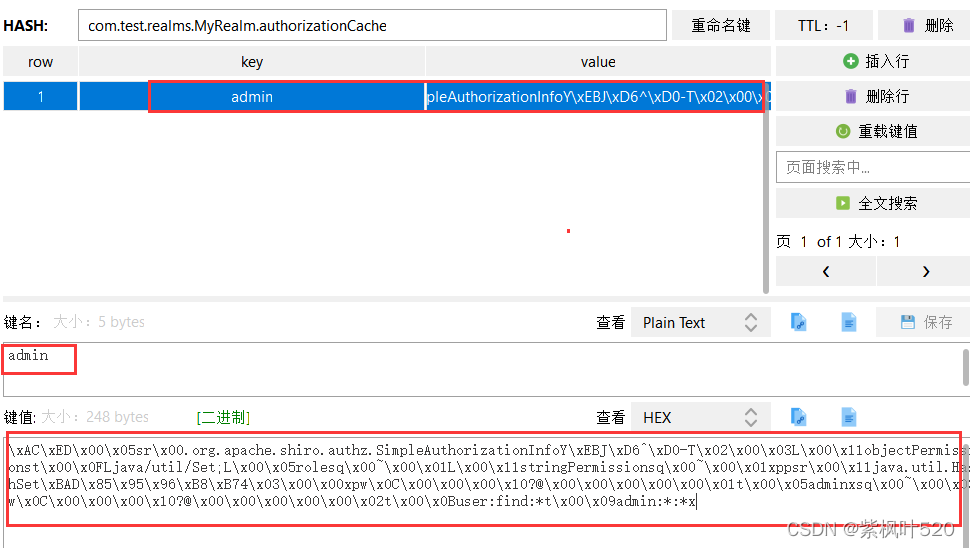
十、添加验证码
1、先创建一个验证码生成工具VerifyCodeUtils
public class VerifyCodeUtils {
//使用到Algerian字体,系统里没有的话需要安装字体,字体只显示大写,去掉了1,0,i,o几个容易混淆的字符
public static final String VERIFY_CODES = "23456789ABCDEFGHJKLMNPQRSTUVWXYZ";
private static Random random = new Random();
/**
* 使用系统默认字符源生成验证码
* @param verifySize 验证码长度
* @return
*/
public static String generateVerifyCode(int verifySize){
return generateVerifyCode(verifySize, VERIFY_CODES);
}
/**
* 使用指定源生成验证码
* @param verifySize 验证码长度
* @param sources 验证码字符源
* @return
*/
public static String generateVerifyCode(int verifySize, String sources){
if(sources == null || sources.length() == 0){
sources = VERIFY_CODES;
}
int codesLen = sources.length();
Random rand = new Random(System.currentTimeMillis());
StringBuilder verifyCode = new StringBuilder(verifySize);
for(int i = 0; i < verifySize; i++){
verifyCode.append(sources.charAt(rand.nextInt(codesLen-1)));
}
return verifyCode.toString();
}
/**
* 生成随机验证码文件,并返回验证码值
* @param w
* @param h
* @param outputFile
* @param verifySize
* @return
* @throws IOException
*/
public static String outputVerifyImage(int w, int h, File outputFile, int verifySize) throws IOException {
String verifyCode = generateVerifyCode(verifySize);
outputImage(w, h, outputFile, verifyCode);
return verifyCode;
}
/**
* 输出随机验证码图片流,并返回验证码值
* @param w
* @param h
* @param os
* @param verifySize
* @return
* @throws IOException
*/
public static String outputVerifyImage(int w, int h, OutputStream os, int verifySize) throws IOException{
String verifyCode = generateVerifyCode(verifySize);
outputImage(w, h, os, verifyCode);
return verifyCode;
}
/**
* 生成指定验证码图像文件
* @param w
* @param h
* @param outputFile
* @param code
* @throws IOException
*/
public static void outputImage(int w, int h, File outputFile, String code) throws IOException{
if(outputFile == null){
return;
}
File dir = outputFile.getParentFile();
if(!dir.exists()){
dir.mkdirs();
}
try{
outputFile.createNewFile();
FileOutputStream fos = new FileOutputStream(outputFile);
outputImage(w, h, fos, code);
fos.close();
} catch(IOException e){
throw e;
}
}
/**
* 输出指定验证码图片流
* @param w
* @param h
* @param os
* @param code
* @throws IOException
*/
public static void outputImage(int w, int h, OutputStream os, String code) throws IOException{
int verifySize = code.length();
BufferedImage image = new BufferedImage(w, h, BufferedImage.TYPE_INT_RGB);
Random rand = new Random();
Graphics2D g2 = image.createGraphics();
g2.setRenderingHint(RenderingHints.KEY_ANTIALIASING,RenderingHints.VALUE_ANTIALIAS_ON);
Color[] colors = new Color[5];
Color[] colorSpaces = new Color[] { Color.WHITE, Color.CYAN,
Color.GRAY, Color.LIGHT_GRAY, Color.MAGENTA, Color.ORANGE,
Color.PINK, Color.YELLOW };
float[] fractions = new float[colors.length];
for(int i = 0; i < colors.length; i++){
colors[i] = colorSpaces[rand.nextInt(colorSpaces.length)];
fractions[i] = rand.nextFloat();
}
Arrays.sort(fractions);
g2.setColor(Color.GRAY);// 设置边框色
g2.fillRect(0, 0, w, h);
Color c = getRandColor(200, 250);
g2.setColor(c);// 设置背景色
g2.fillRect(0, 2, w, h-4);
//绘制干扰线
Random random = new Random();
g2.setColor(getRandColor(160, 200));// 设置线条的颜色
for (int i = 0; i < 20; i++) {
int x = random.nextInt(w - 1);
int y = random.nextInt(h - 1);
int xl = random.nextInt(6) + 1;
int yl = random.nextInt(12) + 1;
g2.drawLine(x, y, x + xl + 40, y + yl + 20);
}
// 添加噪点
float yawpRate = 0.05f;// 噪声率
int area = (int) (yawpRate * w * h);
for (int i = 0; i < area; i++) {
int x = random.nextInt(w);
int y = random.nextInt(h);
int rgb = getRandomIntColor();
image.setRGB(x, y, rgb);
}
shear(g2, w, h, c);// 使图片扭曲
g2.setColor(getRandColor(100, 160));
int fontSize = h-4;
Font font = new Font("Algerian", Font.ITALIC, fontSize);
g2.setFont(font);
char[] chars = code.toCharArray();
for(int i = 0; i < verifySize; i++){
AffineTransform affine = new AffineTransform();
affine.setToRotation(Math.PI / 4 * rand.nextDouble() * (rand.nextBoolean() ? 1 : -1), (w / verifySize) * i + fontSize/2, h/2);
g2.setTransform(affine);
g2.drawChars(chars, i, 1, ((w-10) / verifySize) * i + 5, h/2 + fontSize/2 - 10);
}
g2.dispose();
ImageIO.write(image, "jpg", os);
}
private static Color getRandColor(int fc, int bc) {
if (fc > 255)
fc = 255;
if (bc > 255)
bc = 255;
int r = fc + random.nextInt(bc - fc);
int g = fc + random.nextInt(bc - fc);
int b = fc + random.nextInt(bc - fc);
return new Color(r, g, b);
}
private static int getRandomIntColor() {
int[] rgb = getRandomRgb();
int color = 0;
for (int c : rgb) {
color = color << 8;
color = color | c;
}
return color;
}
private static int[] getRandomRgb() {
int[] rgb = new int[3];
for (int i = 0; i < 3; i++) {
rgb[i] = random.nextInt(255);
}
return rgb;
}
private static void shear(Graphics g, int w1, int h1, Color color) {
shearX(g, w1, h1, color);
shearY(g, w1, h1, color);
}
private static void shearX(Graphics g, int w1, int h1, Color color) {
int period = random.nextInt(2);
boolean borderGap = true;
int frames = 1;
int phase = random.nextInt(2);
for (int i = 0; i < h1; i++) {
double d = (double) (period >> 1)
* Math.sin((double) i / (double) period
+ (6.2831853071795862D * (double) phase)
/ (double) frames);
g.copyArea(0, i, w1, 1, (int) d, 0);
if (borderGap) {
g.setColor(color);
g.drawLine((int) d, i, 0, i);
g.drawLine((int) d + w1, i, w1, i);
}
}
}
private static void shearY(Graphics g, int w1, int h1, Color color) {
int period = random.nextInt(40) + 10; // 50;
boolean borderGap = true;
int frames = 20;
int phase = 7;
for (int
